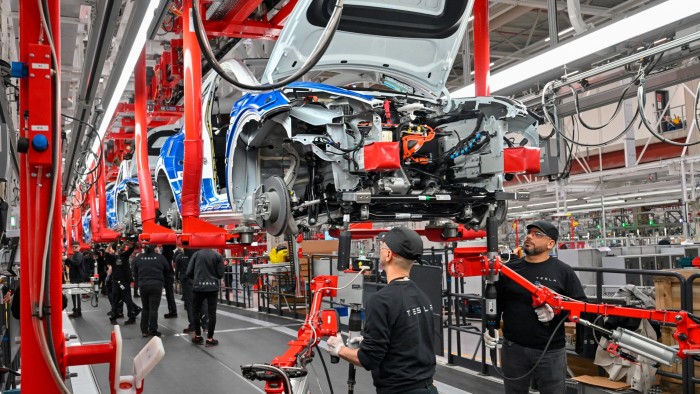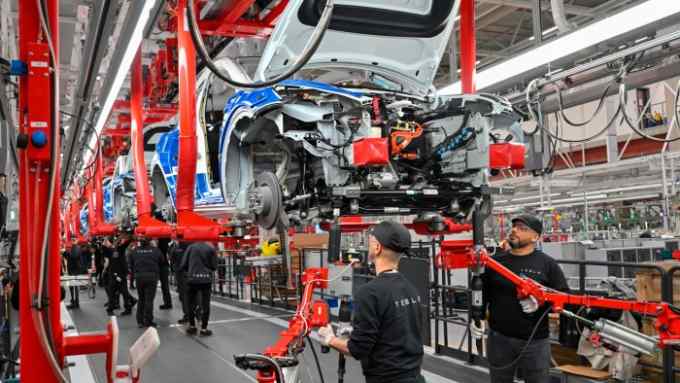Panasonic makes the case for measuring ‘avoided emissions’

Roula Khalaf, Editor of the FT, selects her favourite stories in this weekly newsletter.
Few chief executives would dare to admit that they were ever less than fully engaged with global warming — but Yuki Kusumi is one of those few. The Panasonic boss freely confesses that climate change was not a top priority when he ran the Japanese group’s automotive business.
“To be honest, I wasn’t really interested in climate change, since I was too busy with the business in front of me, but I realise that was not acceptable,” Kusumi says in an interview with the FT in Tokyo.
But, since April 2021, when the 58-year-old left the car division to take the helm of the parent conglomerate, he has undergone a striking change of heart. Kusumi has pushed Panasonic’s so-called “green impact” initiatives to the forefront of its growth ambitions, often invoking founder Konosuke Matsushita’s words that the company is “a public institution of society”.
Panasonic — along with fellow conglomerate Hitachi, air conditioner maker Daikin and other Japanese businesses — has also been at the forefront of a government-backed campaign to adopt a new metric to assess a company’s efforts towards achieving carbon neutrality goals.
The concept of so-called ‘avoided’ — or Scope 4 — emissions is based on the idea that investors should look beyond a company’s efforts to reduce greenhouse gas (GHG) emissions in its own operations and supply chains to consider the contributions made to society and the economy by its energy-saving products and services.
For Panasonic — whose sprawling operations produce everything from air conditioners and washing machines to car batteries and robots — current environmental metrics are problematic.

The group supplies car batteries to US electric-car maker Tesla, for example, which means that both companies are helping lower worldwide GHG emissions, as consumers switch from petrol vehicles. But batteries are highly carbon intensive to produce, resulting in significant emissions from Panasonic’s own factories and supply chains.
Under the three metrics defined by the Greenhouse Gas Protocol, a widely used reporting framework, those emissions all mount up to Panasonic’s disadvantage: Scope 1 emissions come directly from a company’s own operations; Scope 2 from generating the energy it buys; and Scope 3 from the rest of its value chain.
But factoring in avoided emissions would significantly reduce the cumulative total — and would, Kusumi argues, provide a more complete picture of his company’s environmental impact.
Under its latest climate plan, Panasonic has pledged to reduce CO₂ emissions from its operations to virtually net zero by 2030. It also aims to reduce total emissions by more than 300mn tonnes by 2050, or about 1 per cent of current global emissions.
Two-thirds of that total cut would be through avoided emissions, achieved via the sale of existing products such as car batteries, heat pumps and hydrogen fuel cells, as well as new technologies and businesses.
“Our customers are strongly urging for reduction in Scope 1 and 2 emissions so we will meet those demands,” Kusumi says, although he cautions that the company’s Scope 3 efforts could be impeded by the global energy crisis caused by the war in Ukraine. “In addition, we will contribute to the reduction of emissions by our customers, and there is a real business opportunity there.”
For Tatsuo Ogawa, Panasonic’s chief technology officer, the challenge is to make sure that avoided emissions become a global standard with proper guidelines on measurement. “We don’t want this to be a Galápagos-style movement that is only in Japan,” he says. “We want to make sure it’s global.”
There are signs that the concept is gaining traction in the global asset management industry, with London-based Schroders, the Netherlands’ Robeco, and France’s Mirova backing a new avoided emissions metric to expand climate finance.
Environment ministers at the G7 meeting in April also agreed that there was value in acknowledging avoided emissions, while the World Business Council for Sustainable Development, a trade organisation, released guidance on how to assess avoided emissions in March.
“When investors do a financial analysis of a company, they look at various metrics, including sales, profit and return on equity,” says Teppei Yamaga, head of the net zero strategy department at Nomura Asset Management.
“So it is strange to primarily analyse [only reductions in] CO₂ emissions when it comes to ESG investing, especially when there is a risk of an inverse correlation between that metric and economic growth and investment returns.”
But critics say there is a risk of greenwashing with avoided emissions, because the metric allows too much room for subjective judgments in quantifying the potential benefits from a new product or service. While the environmental impact of selling batteries for EVs is clear for Panasonic, the promises it has made about emissions reductions using future technologies are difficult to verify.
“It allows companies who utilise avoided emissions to theoretically inflate demand for products and services that should be phased out in the first place,” says Kim Schumacher, associate professor in sustainable finance at Kyushu University. “Making something less unsustainable does not make it sustainable. You just make it less unsustainable.”
Dimitri Lafleur, chief scientist at the Australasian Centre for Corporate Responsibility, says adding a new metric would be a distraction from the emissions reduction efforts companies are currently making.
“Rather than adding a new metric, I think we should be looking at how we can improve existing metrics,” Lafleur says. “How do you quantify whether things have actually been avoided? That’s a very difficult exercise. If it’s actually been avoided, then it should have already been factored in by Scope 1, 2 or 3.”
Kusumi, however, insists that Scope 4 is needed to capture fully companies’ emissions performance. “If we are measured by the increase in carbon emissions when we increase the manufacturing of batteries, then it might be better for us to stop making batteries,” he says. “But then we won’t be able to accelerate the CO₂ reduction efforts on Earth as a whole. That’s why we need to pay attention to avoided emissions as well.”

Comments